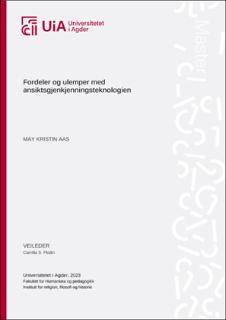| dc.description.abstract | We live in an era where digital technologies constitute a large part of our daily life. This is also true for Facial Recognition Technologies (FRT). This Master thesis is divided into five parts: Introduction, methods, and the research approach, historical background, discussion, and a conclusion. The research question I address is: “What are the advantages and disadvantages with FRT?”. To answer this question, I explore ethical problems, from the perspective of consequentialism, and more specifically utilitarianism. Utilitarianism is a theory that prescribes right from wrong, by focusing on what will provide happiness and well-being for the greatest number of people in society. Jeremy Bentham (1748—1832) and John Stuart Mill (1800-1873) are proponents of utilitarianism, which is a relevant theory for addressing my research question, since I investigate what can bring us happiness and well-being. It is a relevant theory when examining advantages and disadvantages to judge what will provide happiness for the majority of the people. One of the arguments for using FRT in surveillance concerns society’s safety and well-being. It is a claimed to prevent crimes. Even though privacy is not usually something that is usually discussed from the point of view of utilitarianism, I have a strong focus on this in my examine. This is because from my point of view society will be a better for all when people know which rights, they have for protecting their privacy. This Master thesis has a theoretical framework, and I used academic work from several research fields (e.g. philosophy, criminology, and computer science) that addresses both the advantages and the disadvantages of using FRT.
In the discussion, I examine issues about privacy, how FRT is used in Norway, so called “chilling effects”, crime vs surveillance and bias in the technology. The use of FRT implies both advantages and disadvantages. For example, FRT verification and identification in different social medias, banks etc. FRT also makes it easier for the police to look for evidence for criminal activity by looking at surveillance material, and this has had some positive effects in public places, where criminal acts have decreased. Some of the disadvantages of using FRT are its chilling effects, which means that we change our behavior and become watchful with what we are doing. The greatest disadvantages concern the problem of bias in the data that is used to train the technology. If we are going to use FRT in the future the bias need be fixed with more data that is more representative of the whole population, and not just for one group of people. | |
